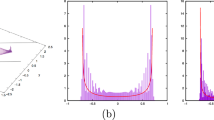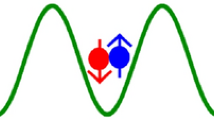Abstract
It is believed that the decoherence will lead to a crossover from quantum to classical for the diffusive behaviour of discrete quantum walk in the long time limit. However, a few systems with sub-ballistic diffusive behaviours have been found in some non-unitary quantum walks. In this paper, we study the one-dimensional discrete quantum walks subject to a short-range hopping decoherence, i.e. with a probability the walker could hop to next-nearest-neighbour lattices unilaterally and/or bilaterally in one time step. We find that, when the decoherence effects only come from the bilateral hopping operation, the diffusive behaviours of quantum walks are sub-ballistic and the distributions of position exhibit three peaks. These results are quite different from those of the previous non-unitary quantum walks. Our results could be used to improve the algorithmic properties of quantum walk due to its faster diffusive speed and more uniform spreading.



Similar content being viewed by others
References
Grover, L.K.: Quantum mechanics helps in searching for a needle in a haystack. Phys. Rev. Lett. 79, 325 (1997). preliminary version in STOC (1996)
Shor, P.W.: Polynomial-time algorithms for prime factorization and discrete algorithms on a quantum computer. SIAM J. Comput. 26(5), 1484–1509 (1997). preliminary version in FOCS (1994)
Aharonov, Y., Davidovich, L., Zagury, N.: Quantum random walks. Phys. Rev. A 48, 1687 (1992)
Farhi, E., Gutmann, S.: Quantum computation and decision trees. Phys. Rev. A 58, 915–928 (1998)
Shenvi, N., Kempe, J., Whaley, K.B.: A quantum random walk search algorithm. Phys. Rev. A 67(5), 052307 (2003)
Ambainis, A., Kempe, J., Rivosh, A.: Coins make quantum walks faster. Proceedings of the 16th ACM-SIAM SODA, pp. 1099–1108, (2005)
Childs, A.M., Goldstone, J.: Spatial search by quantum walk. Phys. Rev. A 70, 022314 (2004)
Ambainis, A.: Quantum search algorithms. SIGACT News 35(2), 22–35 (2004)
Ambainis, A.: New developments in quantum algorithms. In: 35th International Symposium on Mathematical Foundations of Computer Science, pp. 1–11, (2011)
Dur, W., Raussendorf, R., Kendon, V.M., Briegel, H.J.: Quantum walks in optical lattices. Phys. Rev. A 66, 052319 (2002)
Du, J., Li, H., Xu, X., Shi, M., Wu, J., Zhou, X., Han, R.: Experimental implementation of the quantum random-walk algorithm. Phys. Rev. A 67, 042316 (2003)
Ryan, C.A., Laforest, M., Boileau, J.C., Laflamme, R.: Experimental implementation of a discrete-time quantum random walk on an NMR quantum-information processor. Phys. Rev. A 72, 062317 (2005)
Zahringer, F., Kirchmair, G., Gerritsma, R., Solano, E., Blatt, R., Roos, C.F.: Realization of a quantum walk with one and two trapped ions. Phys. Rev. Lett. 104, 100503 (2010)
Schmitz, H., Matjeschk, R., Schneider, Ch., Glueckert, J., Enderlein, M., Huber, T., Schaetz, T.: Quantum walk of a trapped Ion in phase space. Phys. Rev. Lett. 103, 090504 (2009)
Xue, P., Sanders, C.B., Leibfried, D.: Quantum walk on a line for a trapped ion. Phys. Rev. Lett. 103(18), 183602 (2009)
Karski, K., Foster, L., Choi, J.-M., Steffen, A., Alt, W., Meschede, D., Widera, A.: Quantum walk in position space with single optically trapped atoms. Science 325, 174 (2009)
Broome, M.A., Fedrizzi, A., Lanyon, B.P., Kassal, I., Aspuru-Guzik, A., White, A.G.: Discrete single-photon quantum walks with tunable decoherence. Phys. Rev. Lett. 104, 153602 (2010)
Eckert, K., Mompart, J., Birkl, G., Lewenstein, M.: One- and two-dimensional quantum walks in arrays of optical traps. Phys. Rev. A 72, 012327 (2005)
Chandrashekar, C.M.: Implementing the one-dimensional quantum (Hadamard) walk using a Bose–Einstein condensate. Phys. Rev. A 74, 032307 (2006)
Ma, Z.-Y., Burnett, K., dArcy, M.B., Gardiner, S.A.: Quantum random walks using quantum accelerator modes. Phys. Rev. A 73, 013401 (2006)
Perets, H.B., Lahini, Y., Pozzi, F., Sorel, M., Morandotti, R., Silberberg, Y.: Realization of quantum walks with negligible decoherence in waveguide lattices. Phys. Rev. Lett. 100, 170506 (2008)
Chandrashekar, C.M., Laflamme, R.: Quantum phase transition using quantum walks in an optical lattice. Phys. Rev. A 78, 022314 (2008)
Oka, T., Konno, N., Arita, R., Aoki, H.: Breakdown of an electric-field driven system: a mapping to a quantum walk. Phys. Rev. Lett. 94, 100602 (2005)
Kendon, V.: Decoherence in quantum walks: a review. Math. Struct. Comp. Sci. 17, 1169 (2006)
Venegas-Andraca, S.E.: Quantum walks: a comprehensive review. Quantum Inf. Process. 11(5), 1015–1106 (2012)
Brun, T.A., Carteret, H.A., Ambainis, A.: Quantum to classical transition for random walks. Phys. Rev. Lett. 91, 130602 (2003)
Brun, T.A., Carteret, H.A., Ambainis, A.: Quantum random walks with decoherent coins. Phys. Rev. A. 67, 032304 (2003)
Romanelli, A., Siri, R., Abal, G., Auyuanet, A., Donangelo, R.: Decoherence in the quantum walk on the line. Phys. A 347, 137 (2004)
Kos̆ík, J., Buz̆ek, V., Hillery, M.: Quantum walks with random phase shifts. Phys. Rev. A 74, 022310 (2006)
Banerjee, S., Srikanth, R., Chandrashekar, C.M., Rungta, P.: Symmetry-noise interplay in a quantum walk on an n-cycle. Phys. Rev. A 78, 052316 (2008)
Liu, C., Petulante, N.: Quantum walks on the N-cycle subject to decoherence on the coin degree of freedom. Phys. Rev. E 81, 031113 (2010)
Liu, C., Petulante, N.: Asymptotic evolution of quantum walks on the N-cycle subject to decoherence on both the coin and position degrees of freedom. Phys. Rev. A 84, 012317 (2011)
Ampadu, C.: Brun-type formalism for decoherence in two-dimensional quantum walks. Commun. Theor. Phys. 57, 41 (2011)
Oliveira, A.C., Portugal, R., Donangelo, R.: Decoherence in two-dimensional quantum walks. Phys. Rev. A 74(1), 012312 (2006)
Gönülol, M., Aydiner, E., Müstecaplioǧlu, Ö.E.: Decoherence in two-dimensional quantum random walks with traps. Phys. Rev. A 80(2), 022336 (2009)
Alagić, G., Russell, A.: Decoherence in quantum walks on the hypercube. Phys. Rev. A 72, 062304 (2005)
Chandrashekar, C.M., Srikanth, R., Banerjee, S.: Symmetries and noise in quantum walk. Phys. Rev. A 76, 022316 (2007)
Annabestani, M., Akhtarshenas, S.J., Abolhassani, M.R.: Decoherence in a one-dimensional quantum walk. Phys. Rev. A 81, 032321 (2010)
Lopez, C.C., Paz, J.P.: Phase-space approach to the study of decoherence in quantum walks. Phys. Rev. A 68, 052305 (2003)
Zhang, K.: Limiting distribution of decoherent quantum random walks. Phys. Rev. A 77, 062302 (2008)
Fan, S., Feng, Z., Xiong, S., Yang, W.S.: Convergence of quantum random walks with decoherence. Phys. Rev. A 84, 042317 (2011)
Romanelli, A.: Measurements in the Lvy quantum walk. Phys. Rev. A 76, 054306 (2007)
Ribeiro, P., Milman, P., Mosseri, R.: Aperiodic quantum random walks. Phys. Rev. Lett 93, 190503 (2004)
Lavička, H., Potoček, V., Kiss, T., Lutz, E., Jex, I.: Quantum walk with jumps. Eur. Phys. J. D-At. Mol. Opt. Plasma Phys. 64, 119C129 (2011)
Inui, N., Konno, N., Segawa, E.: One-dimensional three-state quantum walk. Phys. Rev. E 72, 056112 (2005)
Kendon, V., Tregenna, B.: Decoherence can be useful in quantum walks. Phys. Rev. A 67, 042315 (2003)
Maloyer, O., Kendon, V.: Decoherence versus entanglement in coined quantum walks. New J. Phys. 9, 87 (2007)
Kendon, V., Maloyer, O.: Optimal computation with non-unitary quantum walks. Theor. Comput. Sci. 394, 187C196 (2008)
Richter, P.C.: Quantum speedup of classical mixing processes. Phys. Rev. A 76, 042306 (2007)
Holevo, A.S.: Statistical Structure of Quantum Theory. Springer, Berlin (2001)
Acknowledgments
The authors thank Ye Xiong and Yi Gao for the critical reading of the manuscript and useful discussions. This work was supported by the National Natural Science Foundation of China (Grant No. 11175087), by National Key Projects for Basic Research of China (Grant No. 2009CB929501) and by the Project on Graduate Students Education and Innovation of Jiangsu Province (Grant No. CXZZ13_0392).
Author information
Authors and Affiliations
Corresponding author
Appendix: the eigenvalues of superoperator \({\mathcal {L}}_{k}\)
Appendix: the eigenvalues of superoperator \({\mathcal {L}}_{k}\)
It is easy to see that \(\lambda =1\) is an eigenvalue of \({\mathcal {L}}_{k}\), and the other eigenvalues are eigenvalues of the three by three submatrix
Let \(\lambda _{1}\), \(\lambda _{2}\) and \(\lambda _{3}\) are eigenvalues of \(M_{k}\), then we have
If \(\lambda =1\) is an eigenvalue of \(M_{k}\), then \(det\left| I-M_{k}\right| \equiv 0\). When \(0<p\le 1\) and \(0\le q<1\), we can find that \(det\left| I-M_{k}\right| =1-a^{2}-b^{2}\ne 0\) for all \(k\). Therefore, \(\lambda =1\) is not an eigenvalue of \(M_{k}\). Similarly,
Hence, \(\lambda =-1\) is also not an eigenvalue of \(M_{k}\).
Now suppose \(\lambda _{1}=e^{i\theta }\) (\(\theta \) is a real number) is a complex eigenvalue of \(M_{k}\), then the conjugate \(\lambda _{2}=e^{-i\theta }\) must also be an eigenvalue of \(M_{k}\). The third eigenvalue is \(\lambda _{3}=a^{2}+b^{2}\) due to \(det\left| M_{k}\right| =\lambda _{1}\lambda _{2}\lambda _{3}\). Therefore, the characteristic polynomial of \(M_{k}\) is given by
On the other hand, we can obtain the characteristic polynomial of \(M_{k}\) directly from Eq. (35), i.e.
Comparing corresponding coefficients of Eqs. (38) and (39), we obtain the following equations:
From the two equations, we find \((1-a^{2}-b^{2})(1-2\cos \theta )=0\). Then, \(\cos \theta \) must be \(1/2\) due to \(1-a^{2}-b^{2}\ne 0\). Substituting \(\cos \theta =1/2\) back into one of equations, we infer that \(1+a^{2}+b^{2}=-b\). This result is impossible since \(1+a^{2}+b^{2}>1>-b\) when \(0<p\le 1\) and \(0\le q<1\). This contradiction implies that \(M_{k}\) has not complex eigenvalue of unit modulus. In conclusion, when \(0<p\le 1\) and \(0\le q<1\), \(\lambda =1\) is only unit modulus eigenvalue of \({\mathcal {L}}_{k}\), the other eigenvalues \(|\lambda |<1\).
On the other hand, when \(0<p<1\) and \(q=1\), we find that \(a=0\) and \(b=1\) for \(k=0,\pm \pi \) and the superoperator \({\mathcal {L}}_{k}\) has four unit modulus eigenvalues.
Rights and permissions
About this article
Cite this article
Zhao, J., Tong, P. One-dimensional quantum walks subject to next-nearest-neighbour hopping decoherence. Quantum Inf Process 14, 2357–2372 (2015). https://doi.org/10.1007/s11128-015-1012-2
Received:
Accepted:
Published:
Issue Date:
DOI: https://doi.org/10.1007/s11128-015-1012-2




